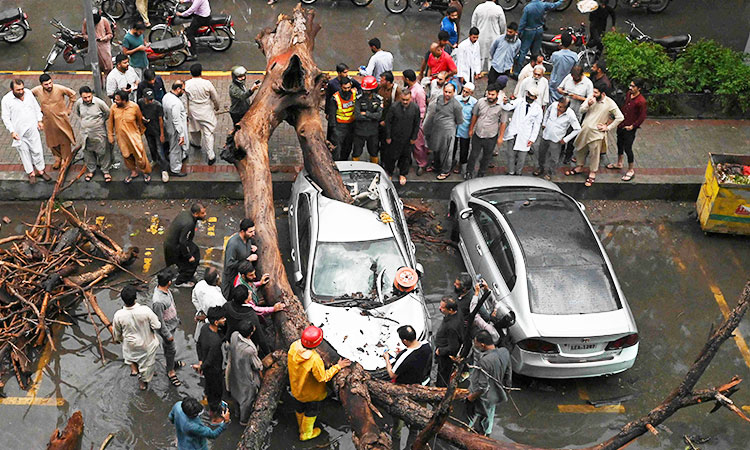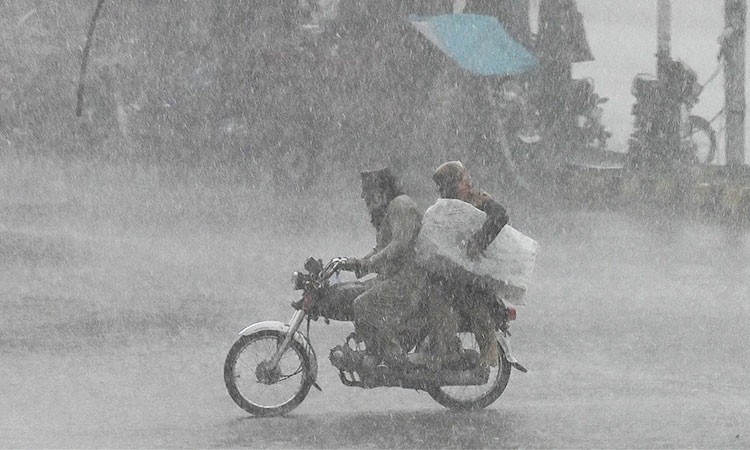Cyclone Biparjoy formed over the Arabian Sea earlier this month
Biparjoy means “disaster” or “calamity” in Bengali.
:quality(70)/cloudfront-eu-central-1.images.arcpublishing.com/thenational/HZ3RZ3CPUHX5ISM7SINR5XAQVQ.jpg)
People have been urged to stay away from the coast, with concerns of high waves as seen in Mumbai in 2022. AP
The National
Jun 11, 2023
Authorities in India and Pakistan have urged people to stay away from the coast as more than 1 million people brace for the arrival of Cyclone Biparjoy, which has increased in strength as it prepares to make landfall.
In a warning on Sunday, India's Meteorological Department said it recorded “phenomenal” conditions over the east-central Arabian Sea with winds of up to 170km per hour.
Fishing communities in the western states of Gujarat, Maharashtra, Goa and other coastal areas have been advised to stop all activity for five days.
People in Pakistan were also urged to stay away from the coastline with the cyclone set to intensify.
Biparjoy means “disaster” or “calamity” in Bengali.
More than 1.8 million people across India and Pakistan are thought to be in the path of the cyclone, according to the Pacific Disaster Centre.
“People should be aware of weather conditions and avoid going to the beach whereas fishermen should avoid boating in the open sea,” said Pakistan's National Disaster Management Authority.
Authorities in Karachi have banned the public from accessing beaches, as well as fishing, sailing and swimming in the sea, Pakistan's Dawn News reported.
However, the paper said “considerable” crowds were pictured at Karachi beaches despite the restrictions.
The storm formed over the Arabian Sea early this month, with Biparjoy being declared a severe cyclone by Oman on June 7, where authorities warned locals to stay away from coastal areas.
India's meteorological department said it will very likely move north until Wednesday morning when it will move north-east towards Pakistan.
Teams from the National Disaster Response Force and State Disaster Response Force have been deployed in the districts most likely to be affected by the storm.
Unstable structures, such as hoardings, have been removed and the electricity department is on standby for power supply disruptions, Reuters reported.
It will hit the coast between the Indian state of Gujarat and Pakistan as a “very severe cyclonic storm” with wind gusts of up to 150km per hour the department said in an update on Sunday.
The Chief Minister of Pakistan's Sindh province has said authorities are prepared to relocate eight to nine thousand “vulnerable” families if needed.
Dozens have already been killed in heavy rains in northern Pakistan.
At least 12 people were buried alive after the roofs and walls of their houses collapsed,” Taimur Ali Khan, a spokesman for the provincial disaster management authority told AFP.
The storms hit four districts of Khyber Pakhtunkhwa province late on Saturday, with 15 people killed in Bannu district, including five siblings aged between two and 11.
More than 140 people were injured and more than 200 livestock died, he said.
Winds and heavy rain kill at least 29, including 8 children, in Pakistan



People gather around a car damaged after a tree fell during a rainfall in Lahore. AFPHeavy rains followed by strong winds killed at least 29 people, including eight children, in northwest Pakistan, officials said on Sunday.
The storms hit four districts of Khyber Pakhtunkhwa province late on Saturday, with five siblings aged between two and 11 among the dead.
"At least 12 people were buried alive after the roofs and walls of their houses collapsed," Taimur Ali Khan, a spokesman for the provincial disaster management authority, told AFP. More than 140 people were injured and more than 200 livestock died, he said.
Authorities have declared an emergency in all four districts.

The affected districts of KP province are Bannu, Lakki Marwat and Karak, senior rescue officer Khateer Ahmed said, uprooting trees and knocking down electrical transmission towers. Officials were working to provide emergency relief to the injured, Ahmed said.
Last year, monsoon rains and flooding devastated Pakistan, killing more than 1,700 people, affecting around 33 million people and displacing nearly 8 million.
To mitigate the effects of natural disasters, the government in its national budget draft presented on Friday allocated $1.3 billion for climate resilience.



People gather around a car damaged after a tree fell during a rainfall in Lahore. AFPHeavy rains followed by strong winds killed at least 29 people, including eight children, in northwest Pakistan, officials said on Sunday.
The storms hit four districts of Khyber Pakhtunkhwa province late on Saturday, with five siblings aged between two and 11 among the dead.
"At least 12 people were buried alive after the roofs and walls of their houses collapsed," Taimur Ali Khan, a spokesman for the provincial disaster management authority, told AFP. More than 140 people were injured and more than 200 livestock died, he said.
Authorities have declared an emergency in all four districts.

The affected districts of KP province are Bannu, Lakki Marwat and Karak, senior rescue officer Khateer Ahmed said, uprooting trees and knocking down electrical transmission towers. Officials were working to provide emergency relief to the injured, Ahmed said.
Last year, monsoon rains and flooding devastated Pakistan, killing more than 1,700 people, affecting around 33 million people and displacing nearly 8 million.
To mitigate the effects of natural disasters, the government in its national budget draft presented on Friday allocated $1.3 billion for climate resilience.

An injured victim of rain storm is treated at a hospital in Bannu. AP
Pakistani Prime Minister Shahbaz Sharif expressed grief over the loss of life loss from the storm and directed authorities to pick up the pace of the relief operation.
Meanwhile, a cyclone is making its way across the Arabian Sea towards the coastlines of Pakistan and India, expected to make landfall at the end of the week.
The "severe and intense” cyclone with wind speeds of 150 kilometres per hour was on a course toward the country’s south, Pakistan's disaster management agency said.
Pakistani authorities said they would begin evacuating between 8,000 and 9,000 families from along the coastline of Sindh province, including in the mega port city of Karachi, home to around 20 million people. The army will be deployed from Monday to assist.

Pakistani Prime Minister Shahbaz Sharif expressed grief over the loss of life loss from the storm and directed authorities to pick up the pace of the relief operation.
Meanwhile, a cyclone is making its way across the Arabian Sea towards the coastlines of Pakistan and India, expected to make landfall at the end of the week.
The "severe and intense” cyclone with wind speeds of 150 kilometres per hour was on a course toward the country’s south, Pakistan's disaster management agency said.
Pakistani authorities said they would begin evacuating between 8,000 and 9,000 families from along the coastline of Sindh province, including in the mega port city of Karachi, home to around 20 million people. The army will be deployed from Monday to assist.

People bathe along the Seaview Beach in Karachi on Sunday. AFP
The cyclone could bring winds, storm surges and urban flooding from Tuesday evening as it approaches, the disaster management agency said Sunday.
"Fishermen are advised not to venture into the open sea until the (weather) system is over by June 17," the agency said.
Prime Minister Shahbaz also ordered officials to put in place emergency measures in advance of the approaching Cyclone Biparjoy in the Arabia Sea.

The cyclone could bring winds, storm surges and urban flooding from Tuesday evening as it approaches, the disaster management agency said Sunday.
"Fishermen are advised not to venture into the open sea until the (weather) system is over by June 17," the agency said.
Prime Minister Shahbaz also ordered officials to put in place emergency measures in advance of the approaching Cyclone Biparjoy in the Arabia Sea.

Motorcyclists ride a motorbike along a street during a rainfall in Lahore. AFP
Scientists say climate change is making seasonal rains heavier and more unpredictable.
Pakistan, which has the world's fifth largest population, is responsible for only 0.8 percent of global greenhouse gas emissions but is one of the most vulnerable nations to extreme weather caused by global warming.
Last summer, unprecedented monsoon rains put a third of the country under water, damaging two million homes and killing more than 1,700 people.
Scientists say climate change is making seasonal rains heavier and more unpredictable.
Pakistan, which has the world's fifth largest population, is responsible for only 0.8 percent of global greenhouse gas emissions but is one of the most vulnerable nations to extreme weather caused by global warming.
Last summer, unprecedented monsoon rains put a third of the country under water, damaging two million homes and killing more than 1,700 people.
June 11,2023
Agencies
No comments:
Post a Comment